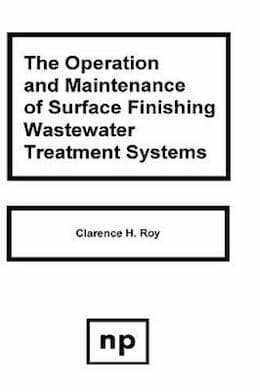
-----
Zero discharge, anyone? Closed loop wastewater treatment
Q. I am interested in how many platers and surface finishers have successfully gone over to closed loop wastewater treatment. Our shop is small, so our methods may not work for all, but we are using carbon treatment plus ion exchange on mixed rinsewaters and have no sewer discharge. Treated water is returned to the rinses. The carbon and resin are regenerated off-site. Bath dumps, strippers, etc. are also sent for outside treatment.

Bill Vins
microwave & cable assemblies - Mesa (what a place-a), Arizona
1995
by Clarence Roy

on eBay or Amazon
or AbeBooks
(affil link)
A. Hi, Bill. Off-site regeneration is very convenient but is wasteful from a chemical consumption perspective because ion exchange intrinsically needs at least twice as much treatment chemicals as precipitation. First you add a large amount of caustic and acid to drive the findings off the resin, then you need to add at least as much again to neutralize what you wastefully added.
BUT! In the real world, where businesspeople are besieged by NIMBY's and bureaucrats, the approach can be a good one. I think that production barrel platers, however, sometimes can't solve their problem this way because the dragout volume and rinse rates are just too high.

Ted Mooney, P.E.
Striving to live Aloha
finishing.com - Pine Beach, New Jersey
P.S. July 2016: This is a very old posting and there are now some clever electrical deionization systems which do not use regeneration chemicals, but generate the necessary hydrogen and hydroxyl ions by splitting water.
As a followup to my original post:
I am curious to see how everyone is dealing with wastes from aqueous cleaning operations. Particularly those sites that used to vapor degrease and have converted to aqueous. Are there any successful zero discharge systems for aqueous cleaner rinses?
This question would apply particularly to those who did not have a wastewater treatment system before setting up the aqueous cleaner.

Bill Vins
microwave & cable assemblies - Mesa (what a place-a), Arizona
1996
Hello again, Bill.
I'd also like to hear from such people too!
It should be no problem to counterflow three rinses to a hot aqueous cleaner, if there is room for them, and achieve zero discharge. But it does result in quicker depletion of the cleaner as you no longer allow a percentage of the dirt, grease, and exhausted cleaner to go out the drain.

Ted Mooney, P.E.
Striving to live Aloha
finishing.com - Pine Beach, New Jersey
1996
Zero-discharge rinsing is certainly an option for hot baths and counterflow rinses. In fact, we are setting a couple of those up in (not that sunny) Rochester, NY.
Will have more information on their performance and how much trouble they'll be giving us in a few months, when full-swing production kicks in.
Cheers from PlaterB

"PlaterB" Berl Stein
NiCoForm, Inc.
Rochester, New York

1996
1996
The writer states that regeneration occurs off-site. Do you think he really means regeneration? There are several makers of Di units that regenerate on site. As far as I know, carbon is ultimately spent and replaced, not regenerated. What do you think of Di units using on site regeneration processes and one made by a California company (i can't remember the name that reuses most of the regen hydrochloric and caustic).
Why do you not think Di is suitable for production barrel platers? If not DI, what is suitable for a closed loop barrel shop? I believe that, in not too distant a future, most areas will not allow any sewer discharges from plating shops, and if nothing else, closed looping helps keep the various government agencies off your back.
Hi, Richard.
Ion-exchange columns can be regenerated on or off site. If regenerated on-site, the regeneration and backwash sends down the sewer all of the metal removed from the rinse water, plus at least twice as much chemical residue as would have been generated by direct end-of-pipe treatment. The super-systems that combine ion-exchange with electrodialyis for rebuilding processes like chromates sound great if they work in production and if a shop can afford $1/4 million+ on one small element of their waste reduction program.
True zero discharge from plating shops, especially barrel plating shops, will not happen soon. In production barrel plating shops, tons of parts are processed per hour, and those parts came in full of scale, paint chips, shop dirt, buffing compound, oils, preservatives, metal filings, detergents, drawing compounds, fingerprints, scale, tarnish, rust, and residues of infinite sorts. Plus, processes like acid dips and chromating work by breaking the process constituents down into a coating plus waste products. The same with most brightener systems. These waste products can't go out on the parts, nor be recovered, so all that stuff goes to waste and "closed loop" doesn't really exist.
A plating shop releases water mixed with contaminants of various sorts. I don't personally like the term "closed loop" because it puts the focus on eliminating the discharge of water instead of focusing on contaminant reduction, and the water surely isn't the problem, the contaminants in it are. Similarly, it is strange for regulatory agencies to say that the thing that can't be discharged is water, and they don't really care much about the actual waste products :-)

Ted Mooney, P.E.
Striving to live Aloha
finishing.com - Pine Beach, New Jersey
1996
Since I seem to have raised more questions and comments than I originally expected, I would like to clarify a few points about my original posting concerning our zero discharge (to sewer) system using ion exchange.
(1) We have a small shop with relatively low flow compared to most.
(2) All plating rinses go to the system. This includes passivate, alkaline cleaner, acid activator, copper cyanide strike, nickel chloride strike, nickel sulfamate, hard acid gold, and cyanide-free silver. No concentrated solutions go to the system.
(3) The system consists of a 20 micron filter followed by three columns, each 3.5 cu ft. First is carbon, then strong acid cation, then strong base anion. Usual output is about 20-30 microsiemens, slightly basic (pH 10). The treated water goes directly back to the rinses. This water is used as makeup in all baths except sulfamate nickel, gold, and silver. We have been running this way for over a year with no problems.
(4) We have averaged one regeneration every four months. Regeneration of carbon/resin is done offsite at a RCRA Part B facility. Regenerated columns are returned to us. All metals are recycled by the regeneration facility.
(5) I firmly believe that this type of system can be adapted to any flow, especially if you want to get out of the city sewer regulatory loop. We save enough in lab fees to help offset some of the cost. Where you can't use ion exchange (oil, chips, etc.) I am sure there are other technologies that can be applied, such as micro-, ultra-, and nano-filtration. The object is to treat RINSES, which are 90-95% or more of the treatment system flow loading, then ship concentrates off-site to a recycler, or if you have the system, do a batch treat on them, make sludge, and send the sludge to a recycler.
The term zero discharge, in my book, means zero discharge to sewer. Closed loop means closed loop on rinses. By the way, we have to add small amounts of deionized water to the system on a regular basis to make up for evaporative losses.

Bill Vins
microwave & cable assemblies - Mesa (what a place-a), Arizona
1996
Some interesting points from your discussions.
First of all, my name is Mike Waite
I've only just found the finishing.com page. Looks good.
My background is technology development for waste minimisation in the nuclear industry. One of the techniques I was involved in developing was for treating the wastes from chemical decontamination operations on nuclear power plant. A variant of this technique looks as though it offers the possibility of true closed loop operation of plating rinse baths.
Potential benefits are:
1) Replace static rinse tank and open loop counter current rinse tanks with closed loop counter current rinse tanks (eliminates water in and effluent out to sewer)
2) 100% metal recovery as powder
3) Anion recovery as concentrate (i.e., SO4 or PO4), or
4) Anion destruction (CN to CO2 + N2)
5) Slight improvement in plating quality (I believe chemical suppliers have modified their chemistries to reduce drag out to reduce effluent loading - but at the expense of slightly poorer plating)
The basic technique is to combine IX with continuous electrochemical regeneration, creating a IX column contained in ion permeable membranes within an electrochemical cell (a bit like membrane dialysis used in the chloralkali industry, but with IX in the middle). In effect the unit operates as an inexhaustible column, with (in cation configuration) metal recovery and (in anion configuration) recovery or destruction. Initially, the carbon column would be kept.
The technique works for the nuclear power industry (taken to pilot scale), but I'd appreciate some information to help the development for this application. Any info you could provide on the following points would be great.
1) Flow rates and metal loading in effluent from countercurrent tanks for a range of plating solutions
2) Frequency of change of static rinse tank, together with metal loading and volume of tank
3) Any info on overall composition, in particular impurity levels from the workpieces and organic levels
The main driving force for this in the UK is the cost of water and sewer discharge, which has increased dramatically since our water companies have been privatised. The prime market is likely to be the precious metal plating sector
Best wishes, Mike, and thanks for the Gulf Stream
-U.K.
May 16, 2012
Q. I have a similar water treatment process. the only difference is that I also use the treated water to make up the baths.
Recently we started to have a problem with our hard gold bath ( parts had dull finishing)and we found as root cause the DI water.
In your add you said that you do not use this close loop water for make ups. Have you had problems in your process?
Which quality of water you recommend for make ups.
Andrea
Canada
- ON, Canada
Q, A, or Comment on THIS thread -or- Start a NEW Thread
